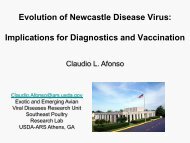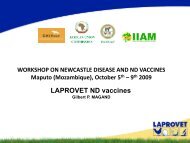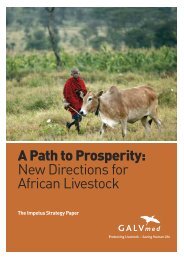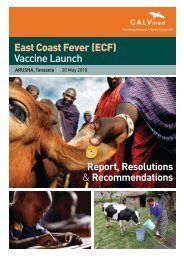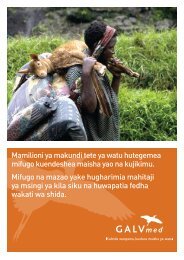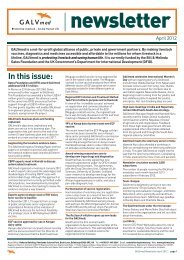Health’s Newcastle vaccine range
Intervet ND vaccines, Celliers.pdf - GALVmed
Intervet ND vaccines, Celliers.pdf - GALVmed
- No tags were found...
Create successful ePaper yourself
Turn your PDF publications into a flip-book with our unique Google optimized e-Paper software.
Intervet Schering Plough Animal<br />
<strong>Health’s</strong> <strong>Newcastle</strong> <strong>vaccine</strong> <strong>range</strong><br />
Dr G Celliers
About the company<br />
• Global leader in<br />
– Research<br />
– Development<br />
– Manufacturing and<br />
– Sale of veterinary medicines<br />
• We offer one of the industry's broadest, most innovative<br />
portfolios, spanning products for the prevention,<br />
treatment and control of disease in all major farm and<br />
companion animal species<br />
Page • 2
Page • 3<br />
About the company
Intervet Schering Plough S.A<br />
• The only company-owned research unit<br />
• Fully accredited Research Unit, based in Malelane<br />
– local and international research and development<br />
• The Intervet sales team is strongly supported by our<br />
Veterinary Services Department and 9 highly qualified<br />
veterinarians<br />
• Intervet South Africa's vision is to be entirely service focused<br />
Page • 4
Why vaccinate for <strong>Newcastle</strong> disease?<br />
• Vaccination protects the bird from ND field strains by<br />
establishing an immunological resistance to infection<br />
• An injected or oral <strong>vaccine</strong> induces the host to generate Abs<br />
against <strong>Newcastle</strong> Disease virus<br />
• During future exposure, the ND field strain is inactivated and<br />
the disease state is prevented<br />
• Vaccines work primarily because the immune system can<br />
remember the identity of the ND virus after the initial<br />
encounter<br />
• ND <strong>vaccine</strong>s establish immunity and memory without the<br />
pathogenic events typical of the initial encounter with a<br />
virulent virus<br />
Page • 5
Why use a live ND <strong>vaccine</strong>?<br />
• <strong>Newcastle</strong> Disease is a respiratory pathogen<br />
• Effective protection requires BOTH local (IgA) and systemic<br />
antibody immunity (IgG and IgM)<br />
• To stimulate local immunity <strong>vaccine</strong> virus must be<br />
administered to the respiratory tract<br />
• Systemic immunity is gained relatively easily as maternal<br />
antibody protection declines rapidly<br />
– chicks can be vaccinated with a live <strong>vaccine</strong> at day old if<br />
using the correct strain<br />
• Aim – application of a <strong>vaccine</strong> that stimulates a good overall<br />
immune response without causing a severe <strong>vaccine</strong> reaction<br />
Page • 6
Advantages of a live <strong>vaccine</strong><br />
• Effective as the <strong>vaccine</strong> virus can express authentic Ags in a<br />
manner that closely resembles natural infection<br />
• Vaccine virus can replicate in host; thereby amplifying the<br />
amount of Ag which activates the release of Abs from B cells<br />
and stimulating T cells<br />
• Can be delivered via the natural route of infection (mucosal<br />
route), thus inducing not only systemic immunity, but also<br />
mucosal immunity<br />
• By developing mucosal immunity, one can prevent the<br />
initiation of infection as well as preventing disease<br />
• Ease of application as they can be applied to the drinking<br />
water or with an eye-dropper<br />
Page • 7
Disadvantages of a live <strong>vaccine</strong><br />
• Undesirable respiratory reactions<br />
• Interference with high ND maternal antibodies<br />
• Short duration of protection. (re-vaccinations)<br />
• Timing of re-vaccination<br />
• Proper application (spray/drinking water)<br />
• Negative effect on total performance<br />
Page • 8
Live ND <strong>vaccine</strong><br />
• Nobilis ND C2<br />
• Nobilis ND La Sota<br />
• Nobilis ND Hitchner B1<br />
• Nobilis ND Clone 30<br />
Page • 9
Live ND <strong>vaccine</strong><br />
Nobilis ND C2<br />
• Indications: Day old chicks and older<br />
• Composition: live, attenuated <strong>Newcastle</strong> disease virus (NDV) strain C2<br />
– strain C2 derived from a Hitchner B1 strain<br />
– clone purified<br />
– <strong>vaccine</strong> virus is safe, stable and gives a predictable <strong>vaccine</strong> response<br />
Page • 10
Live ND <strong>vaccine</strong><br />
Nobilis ND C2<br />
• Administration: via eye-drop, nasal instillation or spray vaccination at<br />
day of age. Target organ is the trachea therefore an effective local<br />
protection is induced in the respiratory organs<br />
• Safe:<br />
– ICPI of 0.06<br />
– droplet size of spray application not critical<br />
– well tolerated in multiple dose experiments<br />
• Vaccination:<br />
– Day old ND C2<br />
– Day 18 ND Clone 30 (2-3 weeks)<br />
Page • 11
Live ND <strong>vaccine</strong><br />
Nobilis ND Hitchner<br />
• Indications: Day old chicks and older<br />
• Composition: live <strong>Newcastle</strong> Disease virus strain Hitchner B1<br />
• Administration: via the drinking water, by spray, by eye-drop or nasal<br />
instillation<br />
• Vaccination:<br />
– safe for use from 1 day of age onwards<br />
– Hitchner B1 can be interfered with by maternal antibodies therefore<br />
recommended use after 2 weeks of age<br />
Page • 12
Live ND <strong>vaccine</strong><br />
Nobilis ND Lasota<br />
• Indications: all fowls older than 14 days<br />
• Composition: live <strong>Newcastle</strong> Disease virus strain Lasota<br />
• Administration: via the drinking water, by spray, by eye-drop or nasal<br />
instillation<br />
• Vaccination:<br />
– Highly effective in protecting chickens with or without maternal antibody<br />
but LaSota is too pathogenic for Day old vaccination<br />
– In fowls an adequate immunity against ND will last for approximately 12<br />
weeks<br />
Page • 13
Live ND <strong>vaccine</strong><br />
Nobilis ND Clone 30<br />
• Indications: Day old chicks and older, recommended for use in high risk<br />
<strong>Newcastle</strong> areas<br />
• Composition: live <strong>Newcastle</strong> Disease <strong>vaccine</strong> virus strain Clone 30<br />
– Clone 30 is a lentogenic ND strain combining the efficacy of LaSota and<br />
the safety of Hitchner B1<br />
– Clone 30 is a clone purified <strong>vaccine</strong><br />
Page • 14
Live ND <strong>vaccine</strong><br />
Nobilis ND Clone 30<br />
• Administration: via the drinking water, by spray, by eye-drop or nasal<br />
instillation<br />
• Vaccination:<br />
– Immunity will last for approximately 6 weeks<br />
– In areas where <strong>Newcastle</strong> Disease is endemic (high risk areas) a<br />
second vaccination should be given within approximately 2-4 weeks<br />
after the first<br />
– Highly effective in protecting chickens with or without maternal antibody<br />
Page • 15
Recommended approach<br />
•1 st vaccination with a „primer‟ Nobilis ND C2<br />
– as early as one day of age<br />
– by coarse spray<br />
– in the hatchery or in the chicken boxes at point of delivery<br />
•2 nd vaccination a „booster‟ Nobilis ND Clone 30<br />
– 14 -17 days later<br />
– best possible ND protection<br />
• Neither safety nor protection against ND is compromised<br />
Page • 16
Why use an inactivated <strong>vaccine</strong>?<br />
• Inactivated <strong>vaccine</strong>s induce a long-lasting and<br />
homogenous antibody response<br />
• In intensive poultry production<br />
– applied after an initial live priming vaccination<br />
• In village poultry<br />
– good results in the absence of an initial vaccination with live<br />
<strong>vaccine</strong> have been reported<br />
(The reason for this is probably that antibodies to the virus<br />
are already present in the village poultry as a result of<br />
previous infection by the wild virus)<br />
Page • 17
Advantages of using an inactivated <strong>vaccine</strong><br />
• No post vaccination systemic reactions<br />
• Long lasting protection<br />
• Produce very high levels of antibodies against NDV<br />
• Provide good protection against the virulent virus<br />
• Less risk of interference<br />
• Much less heat sensitive which makes transporting them<br />
more feasible<br />
• More possibilities for combinations<br />
Page • 18
Disadvantages of using an inactivated <strong>vaccine</strong><br />
• Higher price / dose<br />
• Generally need a live “priming”<br />
• Long lived birds need revaccination<br />
• Individual handling (stress)<br />
• Proper application (injection)<br />
• Training is necessary before any injection technique is<br />
mastered<br />
• Risk of accidental self-injection<br />
• Local reactions<br />
Page • 19
Composition of an inactivated <strong>vaccine</strong><br />
• Antigenic particles (NDV) in the aqueous phase<br />
– The virus is inactivated with formalin<br />
• Adjuvant<br />
– Any substance that enhances the immune response to an<br />
antigen<br />
– All our inactivated ND <strong>vaccine</strong>s are Mineral-in-Oil<br />
• Long lasting protection<br />
• Increased local reaction makes the inactivated virus more<br />
immunogenic<br />
• Slower response<br />
Page • 20
Inactivated ND <strong>vaccine</strong>s<br />
• Nobilis ND Broiler<br />
• Nobilis Newcavac<br />
Page • 21
Inactivated ND <strong>vaccine</strong><br />
• Indications: Day old broiler chicks<br />
Nobilis ND Broiler<br />
• Composition: inactivated <strong>Newcastle</strong> Disease virus<br />
• Administration: Inject 0,1 ml per broiler chicken intramuscularly into the<br />
thigh or subcutaneously into the back of the neck<br />
• Vaccination: Use in combination with live ND <strong>vaccine</strong> (eg. Nobilis ND<br />
Clone 30) provides protection against ND for up to 8 or 9 weeks of age<br />
Page • 22
Inactivated ND <strong>vaccine</strong><br />
Nobilis Newcavac<br />
• Indications: booster vaccination of primed layers and breeding fowls<br />
• Composition: inactivated <strong>Newcastle</strong> Disease virus Clone 30<br />
• Administration: Inject 0,5 ml per bird intramuscularly in breast muscle or<br />
subcutaneously in the lower part of the neck<br />
• Vaccination: Primed fowls should be vaccinated with Nobilis Newcavac<br />
around 16 – 20 weeks, but not less than 4 weeks before the expected<br />
onset of lay<br />
Page • 23
Inactivated Combination ND <strong>vaccine</strong><br />
• Nobilis G + ND<br />
• Nobilis IB + ND<br />
• Nobilis IB + G + ND<br />
• Nobilis EDS + ND<br />
• Nobilis IB + EDS + ND<br />
• Nobilis Reo + IB + G + ND<br />
Page • 24
Inactivated Combination ND <strong>vaccine</strong><br />
Nobilis G + ND<br />
Indications: booster vaccination of future breeders to protect against ND<br />
throughout the laying period, and to induce high maternal antibody levels<br />
against IBD in their offspring<br />
• Composition: ND virus Clone 30 and Gumboro virus strain D78<br />
• Administration: Inject 0,5 ml per bird intramuscularly in the thigh or<br />
breast muscle or subcutaneously in the lower part of the neck<br />
• Vaccination: Administered to birds not less than 4 weeks before the<br />
expected onset of lay. For an optimal booster effect, the birds must be<br />
primed with live <strong>vaccine</strong>s of the separate component strains<br />
Page • 25
Inactivated Combination ND <strong>vaccine</strong><br />
• Indications: future breeding fowls<br />
Nobilis IB + ND<br />
• Composition: immunogenic strains of Infectious Bronchitis virus<br />
(Massachusetts type) and <strong>Newcastle</strong> disease virus<br />
• Administration: Inject 0,5 ml per bird intramuscularly in the thigh or<br />
breast muscle or subcutaneously in the lower part of the neck<br />
• Vaccination: Administered to birds not less than 4 weeks before the<br />
expected onset of lay. For an optimal booster effect, the birds must be<br />
primed with live <strong>vaccine</strong>s of the separate component strains<br />
Page • 26
Inactivated Combination ND <strong>vaccine</strong><br />
Nobilis IB + G + ND<br />
Indications: a booster vaccination for breeding stock to protect against<br />
ND and IB, and to induce high maternal antibody levels against IBD in<br />
their offspring.<br />
• Composition: Inactivated IB strain M41, inactivated Gumboro strain D78,<br />
inactivated ND Clone 30<br />
• Administration: Inject 0,5 ml per bird intramuscularly in the thigh or<br />
breast muscle or subcutaneously in the lower part of the neck<br />
• Vaccination: Administered to birds not less than 4 weeks before the<br />
expected onset of lay. For an optimal booster effect, the birds must be<br />
primed with live <strong>vaccine</strong>s of the separate component strains.<br />
Page • 27
Inactivated Combination ND <strong>vaccine</strong><br />
Nobilis EDS + ND<br />
Indications: a booster vaccination of layers and breeding stock for<br />
protection against Egg Drop Syndrome ‟76 and <strong>Newcastle</strong> Disease<br />
throughout the laying period<br />
• Composition: Inactivated ND Clone 30 virus, inactivated EDS‟76 virus<br />
strain BC14<br />
• Administration: Inject 0,5 ml per bird intramuscularly in the thigh or<br />
breast muscle or subcutaneously in the lower part of the neck<br />
• Vaccination: Administered to birds not less than 4 weeks before the<br />
expected onset of lay. For an optimal booster effect, the birds must be<br />
primed with a live <strong>vaccine</strong> against <strong>Newcastle</strong> Disease<br />
Page • 28
Inactivated Combination ND <strong>vaccine</strong><br />
Nobilis IB + EDS + ND<br />
Indications: a booster vaccination of layers and breeding stock for<br />
protection against Infectious Bronchitis, <strong>Newcastle</strong> Disease and Egg Drop<br />
Syndrome ‟76 throughout the laying period<br />
• Composition: Inactivated IB strain M41, inactivated EDS‟76 virus strain<br />
BC14, inactivated ND Clone 30<br />
• Administration: Inject 0,5 ml per bird intramuscularly in the thigh or<br />
breast muscle or subcutaneously in the lower part of the neck<br />
• Vaccination: Administered to birds not less than 4 weeks before the<br />
expected onset of lay. For an optimal booster effect, the birds must be<br />
primed with a live <strong>vaccine</strong> against Infectious Bronchitis and <strong>Newcastle</strong><br />
Disease<br />
Page • 29
Inactivated Combination ND <strong>vaccine</strong><br />
Page • 30<br />
Nobilis Reo + IB + G + ND<br />
Indications: a booster vaccination of breeding stock for protection against<br />
Infectious Bronchitis and for protection against <strong>Newcastle</strong> Disease. Also<br />
for immunisation against Reovirus infection and Infectious Bursal Disease<br />
virus, in order to protect the offspring of the vaccinated birds for at least<br />
the first weeks of life<br />
• Composition: Inactivated IBV strain M41, Inactivated NDV virus Clone<br />
30, Inactivated IBDV strain D78, Inactivated Reo virus strains 1733 and<br />
2408.<br />
• Administration: Inject 0,5 ml per bird intramuscularly in the thigh or<br />
breast muscle or subcutaneously in the lower part of the neck<br />
• Vaccination: Administered to birds not less than 4 weeks before the<br />
expected onset of lay. For an optimal booster effect, the birds must be<br />
primed with a live <strong>vaccine</strong> against the separate component strains
New Product on the horizon<br />
• NEWHATCH C2-M<br />
– a freeze dried <strong>vaccine</strong> that combines the virtually nonreactive<br />
C2 strain of ND virus with the well-established<br />
infectious bronchitis (IB) protection provided by IB Ma5<br />
– approved for spray vaccination of chickens one day of age<br />
or older<br />
Page • 31
New Product on the horison<br />
• INNOVAX ND-SB<br />
– is a recombinant <strong>vaccine</strong> utilizing the Turkey Herpes Virus<br />
(HVT) as a vector with the insert of the F (fusion) gene of<br />
NDV, combined with the SB1 type of MDV<br />
– provides protection against both very virulent vvMDV and<br />
virulent NDV with one single in ovo or one day old S.Q<br />
vaccination with no respiratory vaccination reaction.<br />
Page • 32
Choice of <strong>vaccine</strong> and method are critical<br />
• Many factors to consider<br />
• A combination of live and inactivated <strong>vaccine</strong>s are needed<br />
– good local immunity<br />
– long lasting systemic immunity<br />
• Without good management and biosecurity every vaccination<br />
program is at risk of failure<br />
Page • 33
Contact details<br />
Dr. Riaan du Preez (BVSc; MBA)<br />
Business Unit Manager<br />
Sub-Saharan Business Centre<br />
T: +27 (0) 11 923 9341<br />
M:+27 (0) 82 901 8492<br />
F: +27 (0) 86 547 1794<br />
riaan.du.preez@sp.intervet.com



